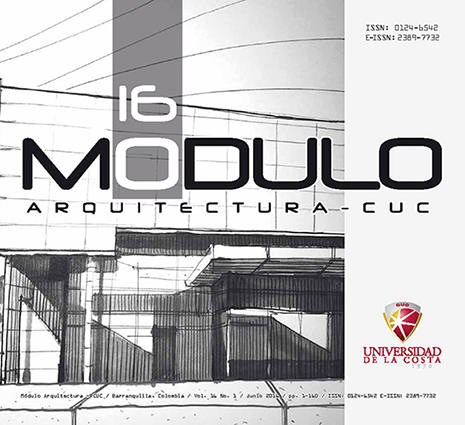ARCHITECTURAL SPACE: OBJECT OF COMMUNICATION AND INTANGIBLE EXPERIENCES
Objeto de comunicación y experiencias intangibles
DOI:
https://doi.org/10.17981/moducuc.16.1.2016.07Keywords:
Architectural space, phenomenology, spatial experience, concept, objectAbstract
This article aims to present a reflection on the evolution of the concept of architectural space,
through history, from a phenomenological perspective and as an object of communication. The
conceptualization of the architectural space has not been unique over time, on the contrary it
has been a process of ideological changes that generally depend on the variety of cultures and
thought. In these cases, perception as a sensory experience has a protagonist role, but we can
not leave aside the phenomenon of spatial experience, which consists of all the experiences,
memories, memories, feelings that are associated with a place or space. This brings us to the
subject of the phenomenology of the architectural space, to the idea of the poetics of the space
of Gastón Bachelard and to the concept of atmosphere of Peter Zumthor.
Downloads
References
Alvarez, L. (2013). Arquitectura y fenomenología. Sobre La arquitectónica de la «indeterminación» en el espacio. Eikasia, 815-836.
Ando, T. (1995). The Pritzker Prize. Loa Angeles: The Hyatt Foundation. Jenson & Walker.
Argan, G. C. (1984). El concepto del espacio arquitectonico, desde el barroco a nuestros dias. Buenos Aires: Ediciones Nueva Vision.
Barreneche, G. (1996). Luz y Espacio en arquitectura. Manizales: Universidad Nacional sede Manizales.
Bermudez, J. (2008). Definiendo lo extraordinario en la arquitectura. Estudios estadisticos de la fenomenologia de lo bello. Revista Latinoamericana de estudios avanzados 14(28), 17-38.
Bermudez, J. (2013). El Rol del ‘Distanciamiento’ en lo Inefable Arquitectónico. Modulo Arquitectura CUC (12), 1(12), 11-25.
Bermudez, J. (2014). Arquitectura extraordinaria: donde materialidad y espritualidad se encuentran. Modulo Arquitectura CUC, 1(13), 101-113.
Cabas, M. (2010). Conceptualizacion del espacio arquitectonico a traves de la historia. Modulo Arquitectura CUC (9), 1(9), 87-103.
Cabas, M. (2011). Lo intangible del espacio arquitectonico. Hito. Revista de arquitectura (25), 1(25), 7-12.
Gadamer, H. (1968). The Relevance of the Beautifil and Other Essays. New York: Cambrigde University Press
Garzón, R. (2012). La arquitectura de Frank Gehry:Espacialidad, envoltorio y yuxtaposición radical. Modulo Arquitectura CUC (11), 171-181.
Giedion, S. (1969). La arquitectura, fenomeno de transicion (las tres edades del espacio en arquitectura). Barcelona: Gustavo Gili.
Goycoolea, R. (1998). Filosofia y arquitectura. A parte rei: revista de filosofia.
Grillo, A. (2005). La arquitectura y la naturaleza compleja: arquitectura, ciencia y mímesis a finales del siglo xx. Tesis de doctorado. Barcelona, catalunya, españa: universitat politècnica de catalunya.
Hardoy, J. (1968). Urban Plannig in Pre-Colombian America. New York: Braziller.
LE Corbusier. (1993). El viaje a oriente. Valencia: Artes Garficas Soler S.A.
LE Corbusier. (2000). The Modulor. Boston: Springer Science & Business Media.
Moline, M. (2011). Bitacora Almendron. Obtenido de Claves de la arquitectura: http://www.almendron.com/artehistoria/arte/arquitectura/las-claves-de-la-arquitectura/ .
Munizaga, G. (1997). Las ciudades y su historia(una aproximacion). Santiago: Universidad Catolica de Chile.
Rasmussen, S. E. (1980). Experiencing Architecture. Cambrigde: MIT Press.
Zevi, B. (1958). Saber ver la arquitectura. Buenos Aires: Editorial Poseidón.
Zevi, B. (1999). Leer, escribir, hablar arquitectura. Barcelona: Ediciones Apostrofe.
Zumthor, P. (2006). Atmosferas. Entornos arquitectonicos. Las cosas a mi alrededor. Barcelona: Gustavo GilI.
Downloads
Published
How to Cite
Issue
Section
License
Copyright (c) 2017 Mauricio Ricardo Cabas García

This work is licensed under a Creative Commons Attribution-NonCommercial-NoDerivatives 4.0 International License.
CC Reconocimiento-NoComercial-SinObrasDerivadas 4.0



 English
English
 Español (España)
Español (España)






